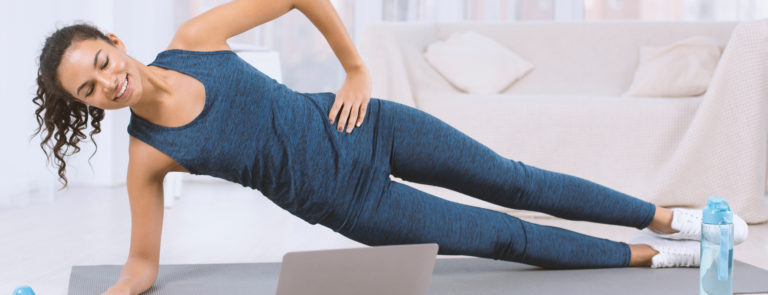Core exercises are an important part of a regular exercise routine.
However, apart from some sit-ups and push-ups, they are often otherwise neglected. And yet core stability is essential for everyone.
So how can you incorporate more core exercises into your exercise programme at home?
What are core exercises and ab exercises?
Core exercises work on the muscles in your pelvis, lower back, hips, and abdomen.
They have a range of benefits, including getting all those muscles working in harmony for balance and stability.
Many sports and most physical activities (such as farming or heavy lifting), depend on strong core muscles.
1
Core muscles can help tone your abdominal muscles. Aerobic exercise and a balanced diet will be important for burning any body fat you are keen to lose, including around your stomach, but it is an ab workout that will strengthen the area.
2
Having a strong core is also helpful for overall posture and for helping to prevent lower back pain and muscle injuries in the area.
Many core exercises can also help improve back pain.
3
The best abs workouts
The great thing about core exercises is they do not typically require any sort of speciality equipment, or even a gym membership.
The following exercises are some of the most beneficial, and they are
home workouts which don’t require any special equipment, as long as you have a bit of space, and some kind of mat, rug, or towel.
A bridge
A bridge, for example, is a classic core exercise.
Lie on your back with your knees bent and your arms by your side. Tighten your abdominal muscles, and raise your hips off the floor, so that your upper legs through to your back are straight.
Hold this position for as long as you can.
4
Stomach crunches
Stomach crunches specifically target your abdominal muscles.
For these, you will lie on your back again, with knees bent and your feet flat on the floor, hip-width apart.
Place your hands on your ears and slowly curl up towards your knees. Do not tuck your neck into your chest. Repeat this move around 12 times.
5
Planking
Planking may make for some fun photos, but it is also a really good move to strengthen your lower back.
Lie on your front with your body straight, propped up on your toes and on your forearms only. Hold the position for five to 10 seconds, and repeat 10 times.
Focus on keeping your lower back straight.
Side plank
A variety of this is the side plank, which works the same core muscles, particularly the lower back.
In this case, you are lying on your side, but propped up on your forearm and elbow of just the arm near the floor, while the other arm is lying along your side. Again, your legs and your whole body should be straight.
6
Stomach crunches with your legs in the air
Finally, stomach crunches with your legs in the air, are perfect for strengthening the lower abdominals.
For these, you will need to lie on your back again, knees bent and feet flat on the floor.
Place your hands across your chest in the coffin pose, and slowly pull your knees into your chest, until your bottom comes off the floor. Keep your knees bent at 90 degrees. Hold for a moment, then release.
7
You will feel this stretch in the back of your legs as well.
Important tips while working out
To get the most out of any workout, it can help to do a five minute warm-up first (a bit of jogging on the spot or something similar will do) plus a five-minute stretch afterwards.
8
Always combine a workout with a great, healthy and balanced diet. Ideally,
a protein-heavy diet if your goals involve building muscle or losing some fat.
9
Listen to your body. For workouts involving core exercises, move to a point where you can feel the stretch and hold it, for full benefits.
However, do not move past this point to where you feel pain. If you have muscle pain or you are feeling fatigued, hold off on exercising for a while.
10
Apart from your body, listening to music can also make a lot of difference. Music can inspire you to move faster (if that’s part of the routine), or harder. It can make the workout pleasant, and it boosts your body’s serotonin and dopamine levels, which foster recover and can see your blood pressure and heart rate going back to normal quicker.
11
Finally, keep hydrated. Exercising can see you sweating out up to 10% of your body weight. This water loss can reduce your performance and your ability to recover.
Dehydration is best avoided, so bring a water bottle with you if you leave the house, or have a large glass of water nearby while working out at home.
Last updated: 19 October 2020
Sources
1
https://www.mayoclinic.org/healthy-lifestyle/fitness/in-depth/core-exercises/art-20044751
2
https://www.mayoclinic.org/healthy-lifestyle/fitness/in-depth/core-exercises/art-20044751
3
https://www.mayoclinic.org/healthy-lifestyle/fitness/in-depth/core-exercises/art-20044751
4
https://www.mayoclinic.org/healthy-lifestyle/fitness/in-depth/core-exercises/art-20044751
5
https://www.nhs.uk/live-well/exercise/10-minute-abs-workout/
6
https://www.nhs.uk/live-well/exercise/10-minute-abs-workout/
7
https://www.nhs.uk/live-well/exercise/10-minute-abs-workout/
8
https://www.sweat.com/blogs/fitness/workout-tips
9
https://www.sweat.com/blogs/fitness/workout-tips
10
https://www.health.harvard.edu/healthbeat/10-tips-for-exercising-safely
11
https://time.com/4237126/13-ways-to-get-the-most-out-of-your-workout-according-to-research/



